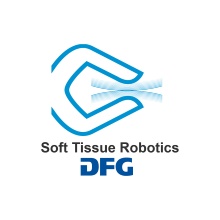Background
Automated handling of soft materials with industrial robots is currently little researched. Difficulties often arise due to the non-linear material behavior and the associated challenges, for example in localization, derivation of gripping positions or control. Within the framework of an international and interdisciplinary research training group, the research topic Soft Tissue Robotics is being worked on in cooperation with the University of Auckland, which is divided into the following individual disciplines:
- Modelling and development of new simulation techniques
- Automation, control and optimization
- Biological and technical concepts of suitable robot kinematics
The ISW contributes its competences in research areas B and C. So far, a cloud-based control architecture as well as possibilities for the localization and simulation of soft materials have been investigated at the ISW. Subsequent use of the topics developed and researched in the Research Training Group can be found in surgery, food processing and in production, for example for automated cable harness assembly.
Problem statement
In today's production environment, industrial robots are characterized in particular by their ability to carry out uniform and unidirectional work processes precisely and reliably. In doing so, they outperform humans in terms of accuracy and endurance. However, they lack the ability to compensate for process uncertainties and to react flexibly to unforeseen changes in the workflow. This creates a "flexibility gap" between the infinitely large configuration space of the flexible object and the often-sequential programming of an industrial robot, when handling flexible components. With the help of flexible robot architectures and a stereo camera, the "flexibility gap" is to be successively resolved.
Goals
With the help of a deformable model, new concepts for handling flexible components will be investigated. A suitable control architecture will be developed that integrates a stereo camera into the manipulation process for dynamic gripping point determination and online feedback during manipulation. In contrast to classical sequential robot programming, goals are formulated in an abstract and task-based manner, which allows more complex manipulations of the deformable object to be carried out.





